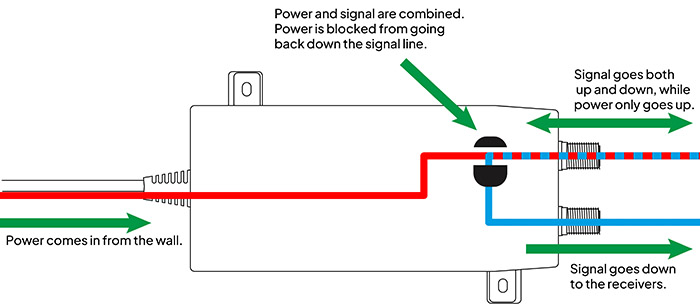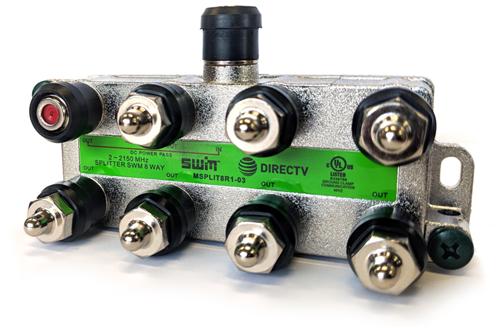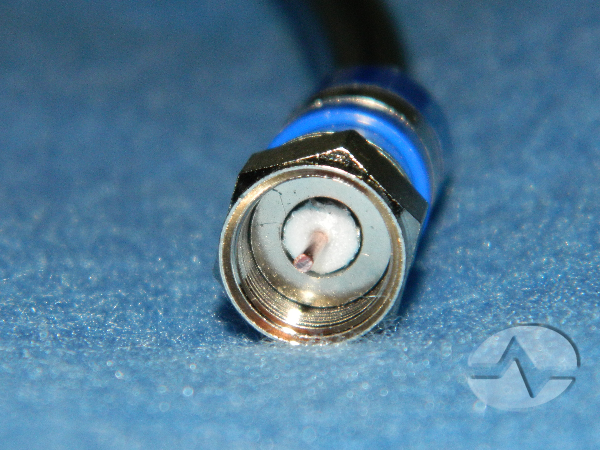What you see above you is DIRECTV’s PI-29Z power inserter. It’s used to power DIRECTV dishes. The idea is that you put it inline between your dish and your receivers and it sends the necessary power up to the line to the dish. DIRECTV’s dishes need a minimum 21 volts of power minimum to run, and most DIRECTV boxes can’t provide it. (The HR54 and Genie 2 are an exception.) Did you ever wonder how one cable can carry a fairly decent amount of voltage and also carry a satellite TV signal? I mean, especially since the power goes one way and most of the signals go the other way. Let’s dive in.
DIRECTV uses the term “power inserter.” A lot of other manufacturers, like Winegard and Televes, use the term “power injector.” Others just call it a “power supply.” It’s true, these terms aren’t completely interchangeable. But for the purposes of this article, it’s close enough. We’re talking about a thing that sends power up a cable otherwise used for signal. Call it what you’d like.
The idea is not only simple, it’s genius. Most homeowners don’t want to do any more wiring than they have to. Keeping the power going up the line used for signal makes a lot of projects easier. It also helps people who are “on the fence” about buying make a decision.
A power inserter, or power injector, is a fairly simple thing. I could bamboozle you with a fancy technical document, but here’s one that novices should be able to understand:

The real key to the whole operation is the part in black. That’s a directional coupler. It puts the power from the wall and the signal from the dish on the same line. It also blocks power from going down the signal line by using something called a DC block. It’s a fairly small part, physically. The part that I didn’t illustrate is the transformers and capacitors that convert alternating current from the wall into direct current for the dish. That’s not really the point of this article.
If you hook up the power inserter backwards, it will send current to your satellite receivers instead of to your dish. The first thing is, your dish won’t work because it’s not getting power. The second thing is a little scarier.
If the line goes straight to the receiver, you’re sending voltage in there that shouldn’t be sent. This can fry some of the parts in the receiver. It’s not pretty and it usually means the receiver needs to be replaced. However, in most cases this doesn’t happen, because of a splitter like this:

DIRECTV’s splitters are a lot more complicated than normal antenna splitters. One thing that’s important to this article is that only one port will pass power. The port with the red center will pass power up the line. The other ports have a DC block in them so that they cannot and will not pass power to the receivers or to the dish. That’s good, because it will protect your receiver from damage (hopefully, best not to test it.)
It has to do with where the current and the signal actually live on the line. If you’re sending power, that power will travel up the wire, and stay in the wire. That’s why it’s important that you use solid copper center conductors for any cable that carries current.

The signal, on the other hand, only exists on the very outer edge of the copper cable. It expands into the white dielectric foam which is designed for this very purpose. That’s why you should never bend a cable hard enough to damage that foam. The relatively large dielectric is part of the reason the cable can carry so much information at the same time.
Where the signal and current intersect, on the very outer edge of the cable, there is some interference but it’s more than compensated for by the large areas where there’s only signal or only current.
All of this didn’t happen by accident. Coaxial cables were first employed in the mid-19th century and there has been constant improvement to them over time. Coaxial cables are capable of carrying signal and power more efficiently than any other design we have. Systems like power-over-Ethernet are fairly limited in the amount of power they can carry, due to the very thin wires they use. Fiber optics, while incredibly fast, can’t carry power. Seems like those 19th-century scientists knew what they were doing.
If you’re thinking of upgrading your satellite, antenna, or any sort of signal for your home or business, call the experts! Solid Signal can help with the smallest installation or the largest, highly technical one. Call us at 888-233-7563 during East Coast business hours or fill out the form below and we’ll get right back to you.
The post How can one cable provide power in one direction and signal in the other? appeared first on The Solid Signal Blog.
Continue reading...
A little side note before I begin
DIRECTV uses the term “power inserter.” A lot of other manufacturers, like Winegard and Televes, use the term “power injector.” Others just call it a “power supply.” It’s true, these terms aren’t completely interchangeable. But for the purposes of this article, it’s close enough. We’re talking about a thing that sends power up a cable otherwise used for signal. Call it what you’d like.
How power injectors work
The idea is not only simple, it’s genius. Most homeowners don’t want to do any more wiring than they have to. Keeping the power going up the line used for signal makes a lot of projects easier. It also helps people who are “on the fence” about buying make a decision.
A power inserter, or power injector, is a fairly simple thing. I could bamboozle you with a fancy technical document, but here’s one that novices should be able to understand:

The real key to the whole operation is the part in black. That’s a directional coupler. It puts the power from the wall and the signal from the dish on the same line. It also blocks power from going down the signal line by using something called a DC block. It’s a fairly small part, physically. The part that I didn’t illustrate is the transformers and capacitors that convert alternating current from the wall into direct current for the dish. That’s not really the point of this article.
What happens if you hook up a power inserter backwards?
If you hook up the power inserter backwards, it will send current to your satellite receivers instead of to your dish. The first thing is, your dish won’t work because it’s not getting power. The second thing is a little scarier.
If the line goes straight to the receiver, you’re sending voltage in there that shouldn’t be sent. This can fry some of the parts in the receiver. It’s not pretty and it usually means the receiver needs to be replaced. However, in most cases this doesn’t happen, because of a splitter like this:

DIRECTV’s splitters are a lot more complicated than normal antenna splitters. One thing that’s important to this article is that only one port will pass power. The port with the red center will pass power up the line. The other ports have a DC block in them so that they cannot and will not pass power to the receivers or to the dish. That’s good, because it will protect your receiver from damage (hopefully, best not to test it.)
How do power and signal coexist on the same line?
It has to do with where the current and the signal actually live on the line. If you’re sending power, that power will travel up the wire, and stay in the wire. That’s why it’s important that you use solid copper center conductors for any cable that carries current.

The signal, on the other hand, only exists on the very outer edge of the copper cable. It expands into the white dielectric foam which is designed for this very purpose. That’s why you should never bend a cable hard enough to damage that foam. The relatively large dielectric is part of the reason the cable can carry so much information at the same time.
Where the signal and current intersect, on the very outer edge of the cable, there is some interference but it’s more than compensated for by the large areas where there’s only signal or only current.
All of this didn’t happen by accident. Coaxial cables were first employed in the mid-19th century and there has been constant improvement to them over time. Coaxial cables are capable of carrying signal and power more efficiently than any other design we have. Systems like power-over-Ethernet are fairly limited in the amount of power they can carry, due to the very thin wires they use. Fiber optics, while incredibly fast, can’t carry power. Seems like those 19th-century scientists knew what they were doing.
Need an upgrade? Call Solid Signal
If you’re thinking of upgrading your satellite, antenna, or any sort of signal for your home or business, call the experts! Solid Signal can help with the smallest installation or the largest, highly technical one. Call us at 888-233-7563 during East Coast business hours or fill out the form below and we’ll get right back to you.
The post How can one cable provide power in one direction and signal in the other? appeared first on The Solid Signal Blog.
Continue reading...

